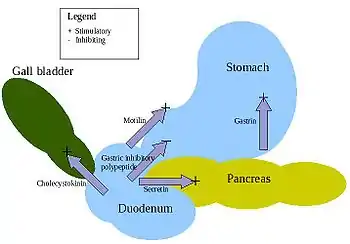APUD cell
APUD cells (DNES cells) constitute a group of apparently unrelated endocrine cells, which were named by the scientist A.G.E. Pearse, who developed the APUD concept in the early 1960s. These cells share the common function of secreting a low molecular weight polypeptide hormone. There are several different types which secrete the hormones secretin, cholecystokinin and several others. The name is derived from an acronym, referring to the following:[1][2]
- Amine Precursor Uptake – for high uptake of amine precursors including 5-hydroxytryptophan (5-HTP) and dihydroxyphenylalanine (DOPA).[2]
- Decarboxylase – for high content of the enzyme amino acid decarboxylase (for conversion of precursors to amines).

Actions of the major digestive hormones secreted by APUD cells
Cells in APUD system
- Adenohypophysis
- Neurons of Hypothalamus
- C-cells of Thyroid
- Chief Cells of Parathyroid
- Adrenal Medullary Cells
- Glomus cells in Carotid Body
- Melanocytes of Skin
- Cells of Pineal Gland
- Renin producing cells in Kidney
See also
References
- Welbourn RB (January 1977). "Current status of the apudomas". Ann. Surg. 185 (1): 1–12. doi:10.1097/00000658-197701000-00001. PMC 1396259. PMID 12724.
- Pearse, A.G. (1969). "The cytochemistry and ultrastructure of polypeptide hormone-producing cells of the APUD series and the embryologic, physiologic and pathologic implications of the concept". J. Histochem. Cytochem. 17 (5): 303–13. doi:10.1177/17.5.303. PMID 4143745.
This article is issued from Wikipedia. The text is licensed under Creative Commons - Attribution - Sharealike. Additional terms may apply for the media files.